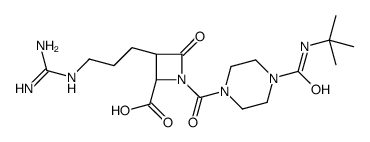253174-92-4
| Name | (2S,3R)-1-[4-(tert-butylcarbamoyl)piperazine-1-carbonyl]-3-[3-(diaminomethylideneamino)propyl]-4-oxoazetidine-2-carboxylic acid |
|---|---|
| Synonyms | 2-Azetidinecarboxylic acid,3-(3-((aminoiminomethyl)amino)propyl)-1-((4-(((1,1-dimethylethyl)amino)carbonyl)-1-piperazinyl)carbonyl)-4-oxo-,(2S,3R) |
| Description | BMS-262084 is a potent, selective and irreversible inhibitor of factor XIa, with an IC50 of 2.8 nM against human factor XIa. BMS-262084 also inhibits human tryptase (IC50=5 nM). BMS-262084 exhibits antithrombotic effects[1][2]. |
|---|---|
| Related Catalog | |
| Target |
IC50: 2.8 nM (factor XIa), 5 nM (tryptase)[1] |
| In Vitro | BMS-262084 shows more than 70-fold selectivity for human factor XIa (IC50=2.8 nM) over tryptase, trypsin, urokinase, plasma kallikrein, plasmin, yhrombin (factor IIa) and Factor IXa (IC50=0.005, 0.05, 0.542, 0.55, 1.7,10.5, and 17.4 μM, respectively)[1]. BMS-262084 (1-100 μM) doubles the activated thromboplastin time in human and rat plasma at 0.14 and 2.2 μM, respectively[1]. |
| In Vivo | BMS-262084 (2-12 mg/kg + 2-12 mg/kg/h; i.v.) reduces carotid artery thrombus weight and improves both vessel patency and integrated flow in rats[1]. Animal Model: Male Sprague Dawley rats (310-390 g) were induced venous thrombosis by FeCl2[1] Dosage: 2 mg/kg + 2 mg/kg/h, 6 mg/kg + 6 mg/kg/h, 12 mg/kg + 12 mg/kg/h Administration: I.v. 10 min before FeCl2 application Result: Reduced carotid artery thrombus weight by 73% at the dose of 12 mg/kg + 12 mg/kg/h. Improved both vessel patency and integrated flow. |
| References |
| Molecular Formula | C18H31N7O5 |
|---|---|
| Molecular Weight | 425.48300 |
| Exact Mass | 425.23900 |
| PSA | 175.65000 |
| LogP | 0.61600 |
| Hazard Codes | Xi |
|---|
